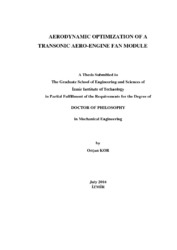Please use this identifier to cite or link to this item:
https://hdl.handle.net/11147/4849Full metadata record
| DC Field | Value | Language |
|---|---|---|
| dc.contributor.advisor | Özkol, Ünver | en_US |
| dc.contributor.author | Kor, Orçun | - |
| dc.date | info:eu-repo/date/embargoEnd/2019-08-04 | - |
| dc.date.accessioned | 2017-02-16T13:16:10Z | - |
| dc.date.available | 2017-02-16T13:16:10Z | - |
| dc.date.issued | 2016-07 | - |
| dc.identifier.citation | Kor, O. (2016). Aerodynamic optimization of a transonic aero-engine fan module. Unpublished doctoral dissertation, İzmir Institute of Technology, İzmir, Turkey | en_US |
| dc.identifier.uri | http://hdl.handle.net/11147/4849 | - |
| dc.description | Thesis (Doctoral)--Izmir Institute of Technology, Mechanical Engineering, Izmir, 2016 | en_US |
| dc.description | Full text release delayed at author's request until 2019.08.04 | en_US |
| dc.description | Includes bibliographical references (leaves: 119-124) | en_US |
| dc.description | Text in English; Abstract: Turkish and English | en_US |
| dc.description | xv, 126 leaves | en_US |
| dc.description.abstract | Aerodynamic design of an aero-engine fan blade is a multi-step process with multi-variables. The general purpose in aerodynamic design is to obtain proper blade angles and flowpath geometry providing the necessary pressure ratio with maximum efficiency, while respecting the structural and aerodynamic constraints. The throughflow design in aerodynamic design procedure is a key step where one can obtain a basic aero-design which generally fixes 80% to 90% of the final fan geometry, by adjusting parameters like blade exit angle distribution, solidity, hub and shroud contour, meridional chord length, etc. Throughout this procedure, the aim of the designer is to obtain an optimum (i.e. light, reliable and robust) system with highest efficiency. Among optimization methods, zero order methods are reported to fit best for turbomachinery problems, due to their good performance in discrete and non-differentiable problems and their ability to find the global optimum. Genetic algorithm is the most widely used optimization method in turbomachinery optimization. Methods inspired by swarm intelligence are reported as promising global optimizers, whereas, to the author’s knowledge, there are no reported studies that employs such algorithms in turbomachinery throughflow optimization. These methods can find the neighborhood that provides the globally optimum design, rather than exactly finding the global design. This drawback is overcome by hybridizing genetic/swarm inspired algorithms by first order (gradient based) methods. Within this aspect, the present study focuses on developing genetic and swarm inspired algorithms hybridized with gradient based algorithms to find the optimum throughflow design of a transonic aero-engine fan module. | en_US |
| dc.description.abstract | Uçak motorlarında fan modülünün aerodinamik tasarımı çok aşamalı ve birden fazla değişkeni kapsayan bir süreçten oluşmaktadır. Fan aerodinamik tasarımında amaç, istenen basınç oranını sağlayacak uygun kanatçık açılarının ve akış yolu geometrisinin, maksimum verim ile yapısal ve aerodinamik kısıtlar göz önünde bulundurarak elde edilmesidir. Aerodinamik tasarımın anahtar aşaması olan aksi-simetrik tasarımdaysa kanatçık çıkış açısı, veter-kanatçık açıklığı oranı, akış yolu geometrisi, meridyonel veter uzunluğu vb. parametreler değiştirilerek en iyi tasarım elde edilir ve fan pali ve modülü geometrisi %80~90 oranında sabitlenir. Bu en iyileştirme süreci esnasında amaç en yüksek verimde çalışan en optimum (en ucuz, en güvenilir ve en dayanıklı) sistemin elde edilmesidir. Optimizasyon metotları arasında sıfırıncı dereceden metotlar, türevlenemez ve süreksiz problemlere uygunlukları ve global optimum noktasını tespit edebilirlikleri dolayısıyla türbomakina optimizasyonuna en uygun olanlarıdır. Bu kapsama giren genetik algoritmalar türbomakina optimizasyonunda yaygın olarak kullanılmaktadır. Sürü davranışlarından esinlenen optimizasyon metotlarının da global optimum noktasını tespit etme konusunda başarılı olduğu bildirilse de, yazarın bildiği kadarıyla bu metotların türbomakina optimizasyonu alanında kullanıldıkları bildirilmemiştir. Öte yandan, genetik algoritmaların ve sürü davranışlarından esinlenen metotların global optimum noktasını tam olarak olmasa da, optimuma en yakın noktaları tespit ettikleri bilinmektedir. Global optimum noktasının kesin olarak tespiti, genetik algoritma ve sürü davranışlarından esinlenen metotların, birinci dereceden (gradyan temelli) metotlarla melezleştirilmesiyle elde edilen yöntemlerin kullanılmasıyla mümkün olmaktadır. Bu çalışma, genetik algoritma ve sürü davranışlarından esinlenen metotların gradyan temelli metotlarla melezleştirilmesiyle elde edilecek yeni bir metot yardımıyla, transonik rejimde çalışan uçak motoru fan palinin ve modülünün aerodinamik aksi-simetrik optimum tasarımının elde edilmesini amaçlamaktadır. | en_US |
| dc.description.sponsorship | TUSAŞ Engine Industries (TEI) | en_US |
| dc.language.iso | en | en_US |
| dc.publisher | Izmir Institute of Technology | - |
| dc.rights | info:eu-repo/semantics/openAccess | en_US |
| dc.subject | Global optimization method | en_US |
| dc.subject | Particle swarm optimization | en_US |
| dc.subject | Axial flow compressor | en_US |
| dc.subject | Turbofan | en_US |
| dc.subject | Aerodynamics | en_US |
| dc.title | Aerodynamic optimization of a transonic aero-engine fan module | en_US |
| dc.title.alternative | Transonik rejimde çalışan uçak motoru fan modülünün aerodinamik optimizasyonu | en_US |
| dc.type | Doctoral Thesis | en_US |
| dc.institutionauthor | Kor, Orçun | - |
| dc.department | Thesis (Doctoral)--İzmir Institute of Technology, Mechanical Engineering | en_US |
| dc.relation.publicationcategory | Tez | en_US |
| item.grantfulltext | open | - |
| item.openairetype | Doctoral Thesis | - |
| item.fulltext | With Fulltext | - |
| item.cerifentitytype | Publications | - |
| item.openairecristype | http://purl.org/coar/resource_type/c_18cf | - |
| item.languageiso639-1 | en | - |
| Appears in Collections: | Phd Degree / Doktora | |
Files in This Item:
| File | Description | Size | Format | |
|---|---|---|---|---|
| T001506.pdf | DoctoralThesis | 3.39 MB | Adobe PDF |  View/Open |
CORE Recommender
Page view(s)
372
checked on Jul 15, 2024
Download(s)
162
checked on Jul 15, 2024
Google ScholarTM
Check
Items in GCRIS Repository are protected by copyright, with all rights reserved, unless otherwise indicated.